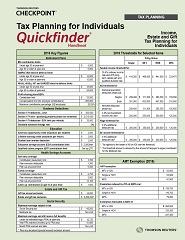We're available Monday to Friday from 8 a.m. to 6 p.m. eastern time.
Need help right now? Call 1-800-431-9025.

The 2025 Tax Planning for Individuals Quickfinder Handbook will be available in May 2025. Pre-order your Handbook today.

Tax rules change from year to year, and sometimes drastically. Whether it’s simply rates and amounts or the addition or expiration of new tax provisions, keeping ahead of clients is a challenge for any tax practitioner. And, many clients expect more from their tax practitioner than just preparing their tax returns. They want their practitioner to alert them to tax-saving ideas or simply be ready when they call with questions throughout the year.
The Tax Planning for Individuals Quickfinder Handbook provides quick answers to a broad range of individual tax planning topics. Unlike other tax planning publications, this Handbook presents the material using Quickfinder’s unique quick reference format that uses many charts, tables and examples plus plain-language descriptions of the tax-saving strategies.
With this Handbook, you’ll get:
See information above for new edition availability. To order the current or prior tax year editions, please call us at 800-431-9025.